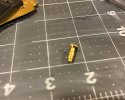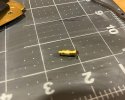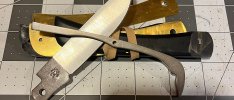DanF
Knifemaker / Craftsman / Service Provider
- Joined
- Apr 17, 2017
- Messages
- 1,509
Case makes a slippie model they call “sodbuster”, which they adapted from an older German model folding butchers/meat cutters knife. Two construction techniques/materials used in this model is a cutlers rivet as a pivot pin (which to me sucks as it is rough as a cob and galls like crazy, and a tension spring that appears to have been made that way so the assembler could adjust the tension without losing a spring or liners from slightly misplaced holes.
The sodbuster is definitely a low budget production knife, but, the profile is very functional and could make a decent user with a few mods to the design. This type spring on this knife is the only one I have seen like it. Does anyone know of any other model knife utilizing this feature?
The sodbuster is definitely a low budget production knife, but, the profile is very functional and could make a decent user with a few mods to the design. This type spring on this knife is the only one I have seen like it. Does anyone know of any other model knife utilizing this feature?




